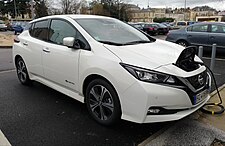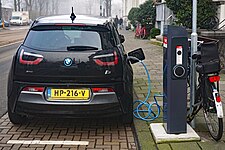| Part of a series on |
| Sustainable energy |
|---|
 |
An electric car or electric vehicle (EV) is a passenger automobile that is propelled by an electric traction motor, using electrical energy as the primary source of propulsion. The term normally refers to a plug-in electric vehicle, typically a battery electric vehicle (BEV), which only uses energy stored in on-board battery packs, but broadly may also include plug-in hybrid electric vehicle (PHEV), range-extended electric vehicle (REEV) and fuel cell electric vehicle (FCEV), which can convert electric power from other fuels via a generator or a fuel cell.
Compared to conventional internal combustion engine (ICE) vehicles, electric cars are quieter, more responsive, have superior energy conversion efficiency and no exhaust emissions, as well as a lower overall carbon footprint from manufacturing to end of life[1][2] (even when a power plant supplying the electricity might add to its emissions). Due to the superior efficiency of electric motors, electric cars also generate less waste heat, thus reducing the need for engine cooling systems that are often large, complicated and maintenance-prone in ICE vehicles.
The electric vehicle battery typically needs to be plugged into a mains electricity power supply for recharging in order to maximize the cruising range. Recharging an electric car can be done at different kinds of charging stations; these charging stations can be installed in private homes, parking garages and public areas.[3] There are also research and development in other technologies such as battery swapping and inductive charging. As the recharging infrastructures (especially those with fast chargers) are still in its relative infancy, range anxiety and time cost are frequent psychological obstacles against electric cars during consumer purchasing decisions.
Worldwide, 10 million plug-in electric cars were sold in 2022, a total of 14% of new car sales,[4] up from 9% in 2021. Many countries have established government incentives for plug-in electric vehicles, tax credits, subsidies, and other non-monetary incentives while several countries have legislated to phase-out sales of fossil fuel cars,[5][6] to reduce air pollution and limit climate change.[7][8] EVs are expected to account for nearly one-fifth of global car sales in 2023, according to the International Energy Agency (IEA).[9]
China currently has the largest stock of electric vehicles in the world, with cumulative sales of 5.5 million units through December 2020,[10] although these figures also include heavy-duty commercial vehicles such as buses, garbage trucks and sanitation vehicles, and only accounts for vehicles manufactured in China.[11][12][13][14][15][16] In the United States and the European Union, as of 2020, the total cost of ownership of recent electric vehicles is cheaper than that of equivalent ICE cars, due to lower fueling and maintenance costs.[17][18]
In 2023 the Tesla Model Y became the world's best selling car.[19] The Tesla Model 3 became the world's all-time best-selling electric car in early 2020,[20] and in June 2021 became the first electric car to pass 1 million global sales.[21] Together with other emerging automotive technologies such as autonomous driving, connected vehicles and shared mobility, electric cars form a future mobility vision called Autonomous, Connected, Electric and Shared (ACES) Mobility.[22][page needed]
- ^ "Reducing Pollution with Electric Vehicles". www.energy.gov. Archived from the original on 12 May 2018. Retrieved 12 May 2018.
- ^ US EPA, OAR (14 May 2021). "Electric Vehicle Myths". www.epa.gov. Retrieved 9 June 2024.
- ^ "How to charge an electric car". Carbuyer. Archived from the original on 23 April 2018. Retrieved 22 April 2018.
- ^ "Executive summary – Global EV Outlook 2023 – Analysis". IEA. Retrieved 17 June 2023.
- ^ "Governor Newsom Announces California Will Phase Out Gasoline-Powered Cars & Drastically Reduce Demand for Fossil Fuel in California's Fight Against Climate Change". California Governor. 23 September 2020. Retrieved 26 September 2020.
- ^ Groom, David Shepardson, Nichola (29 September 2020). "U.S. EPA chief challenges California effort to mandate zero emission vehicles in 2035". Reuters. Retrieved 29 September 2020.
{{cite news}}: CS1 maint: multiple names: authors list (link) - ^ Thunberg, Greta; Anable, Jillian; Brand, Christian (2022). "Is the Future Electric?". The Climate Book. Penguin. pp. 271–275. ISBN 978-0593492307.
- ^ "EU proposes effective ban for new fossil-fuel cars from 2035". Reuters. 14 July 2021. Retrieved 6 August 2021.
- ^ "IEA: EVs Will Account For 20% Of All Car Sales This Year". OilPrice.com. Retrieved 17 June 2023.
- ^ "How China put nearly 5 million new energy vehicles on the road in one decade | International Council on Clean Transportation". theicct.org. 28 January 2021. Retrieved 30 October 2021.
- ^ Liu Wanxiang (12 January 2017). "中汽协:2016年新能源汽车产销量均超50万辆,同比增速约50%" [China Auto Association: 2016 new energy vehicle production and sales were over 500,000, an increase of about 50%] (in Chinese). D1EV.com. Retrieved 12 January 2017. Chinese sales of new energy vehicles in 2016 totaled 507,000, consisting of 409,000 all-electric vehicles and 98,000 plug-in hybrid vehicles.
- ^ Automotive News China (16 January 2018). "Electrified vehicle sales surge 53% in 2017". Automotive News China. Retrieved 22 May 2020. Chinese sales of domestically-built new energy vehicles in 2017 totaled 777,000, consisting of 652,000 all-electric vehicles and 125,000 plug-in hybrid vehicles. Sales of domestically-produced new energy passenger vehicles totaled 579,000 units, consisting of 468,000 all-electric cars and 111,000 plug-in hybrids. Only domestically built all-electric vehicles, plug-in hybrids and fuel cell vehicles qualify for government subsidies in China.
- ^ "中汽协:2018年新能源汽车产销均超125万辆,同比增长60%" [China Automobile Association: In 2018, the production and sales of new energy vehicles exceeded 1.25 million units, a year-on-year increase of 60%] (in Chinese). D1EV.com. 14 January 2019. Retrieved 15 January 2019. Chinese sales of new energy vehicles in 2018 totaled 1.256 million, consisting of 984,000 all-electric vehicles and 271,000 plug-in hybrid vehicles.
- ^ Kane, Mark (4 February 2020). "Chinese NEVs Market Slightly Declined In 2019: Full Report". InsideEVs.com. Retrieved 30 May 2020. Sales of new energy vehicles totaled 1,206,000 units in 2019, down 4.0% from 2018, and includes 2,737 fuel cell vehicles. Battery electric vehicle sales totaled 972,000 units (down 1.2%) and plug-in hybrid sales totaled 232,000 vehicles (down 14.5%). Sales figures include passenger cars, buses and commercial vehicles..
- ^ China Association of Automobile Manufacturers (CAAM) (14 January 2021). "Sales of New Energy Vehicles in December 2020". CAAM. Retrieved 8 February 2021. NEV sales in China totaled 1.637 million in 2020, consisting of 1.246 million passenger cars and 121,000 commercial vehicles.
- ^ China Association of Automobile Manufacturers (CAAM) (12 January 2022). "Sales of New Energy Vehicles in December 2021". CAAM. Retrieved 13 January 2022. NEV sales in China totaled 3.521 million in 2021 (all classes), consisting of 3.334 million passenger cars and 186,000 commercial vehicles.
- ^ Preston, Benjamin (8 October 2020). "EVs Offer Big Savings Over Traditional Gas-Powered Cars". Consumer Reports. Retrieved 22 November 2020.
- ^ "Electric Cars: Calculating the Total Cost of Ownership for Consumers" (PDF). BEUC (The European Consumer Organisation). 25 April 2021. Archived (PDF) from the original on 16 May 2021.
- ^ "The Tesla Model Y Is The Best-Selling Car In The World | GreenCars". www.greencars.com. Retrieved 3 September 2023.
- ^ Holland, Maximilian (10 February 2020). "Tesla Passes 1 Million EV Milestone & Model 3 Becomes All Time Best Seller". CleanTechnica. Archived from the original on 12 April 2020. Retrieved 15 May 2020.
- ^ Cite error: The named reference
1miModel3was invoked but never defined (see the help page). - ^ Hamid, Umar Zakir Abdul (2022). Autonomous, Connected, Electric and Shared Vehicles: Disrupting the Automotive and Mobility Sectors. US: SAE. ISBN 978-1468603477. Retrieved 11 November 2022.



